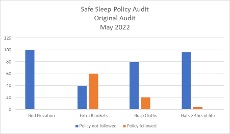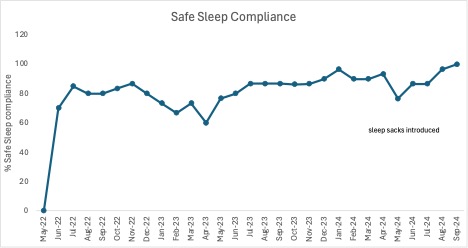Neonatal Quality Improvement 3
Session: Neonatal Quality Improvement 3
087 - Improving Safe Sleep Compliance
Friday, April 25, 2025
5:30pm - 7:45pm HST
Publication Number: 87.5481
Zara N. Ilahi, Yale School of Medicine, Greenwich, CT, United States; Emma Eschricht, Greenwich Hospital, Old Greenwich, CT, United States; Shruti Gupta, Yale School of Medicine, Westport, CT, United States

Zara N. Ilahi, MD (she/her/hers)
Attending Physician
Yale School of Medicine
Staten Island University Hospital, Northwell Health
Greenwich, Connecticut, United States
Presenting Author(s)
Background: Despite efforts to improve education about safe sleep, the number of sleep-related infant deaths has remained steady since 2000. It is imperative for nurseries to promote and practice safe sleep habits immediately from the time of birth and to continue to educate parents to ensure that appropriate safe sleep practice continues at home.
Objective: To improve safe sleep policy compliance from a baseline of 0% (May 2022) to 90% in the NICU and well- baby nursery (WBN) by September 2024.
Design/Methods: This was a one-step initiative quality improvement project aiming to improve compliance of safe sleep at Greenwich Hospital, a community hospital with 3,000 deliveries per year and a 15- bed level III-b NICU. Policy compliance of the hospital’s safe sleep guidelines were reviewed and an audit was performed prior to the start of this initiative. 100% of the beds in the WBN were elevated, 40% had extra blankets, 80% had burp clothes, and 97% had hats at greater than 4 hours of life (figure 1). Interventions were as follows: Education for NICU and WBN nurses at staff meetings, a contact expert was brought in for a zoom conference (for both providers and nurses), baseline data and compliance with safe sleep was shared with staff, WBN and NICU nursing champions were identified, monthly audits were conducted, and the use of sleep sacks were promoted.
Results: Immediately after implementing this QI initiative, safe sleep compliance increased to 70%. The average compliance over the next 28 months was 83% with a median of 86.4%.
Conclusion(s): By systematically presenting and promoting safe sleep awareness, we were able to increase safe sleep compliance from 0% to a median of 86.4% by September of 2024. While we did not meet our goal of 90%, we were able to significantly and consistently increase safe sleep compliance throughout a 28-month period. Further PDSA cycles and analysis of barriers to compliance will be completed in order to meet our goals.
Safe sleep audit prior to study intervention

Safe sleep policy compliance after implementing the initiative



